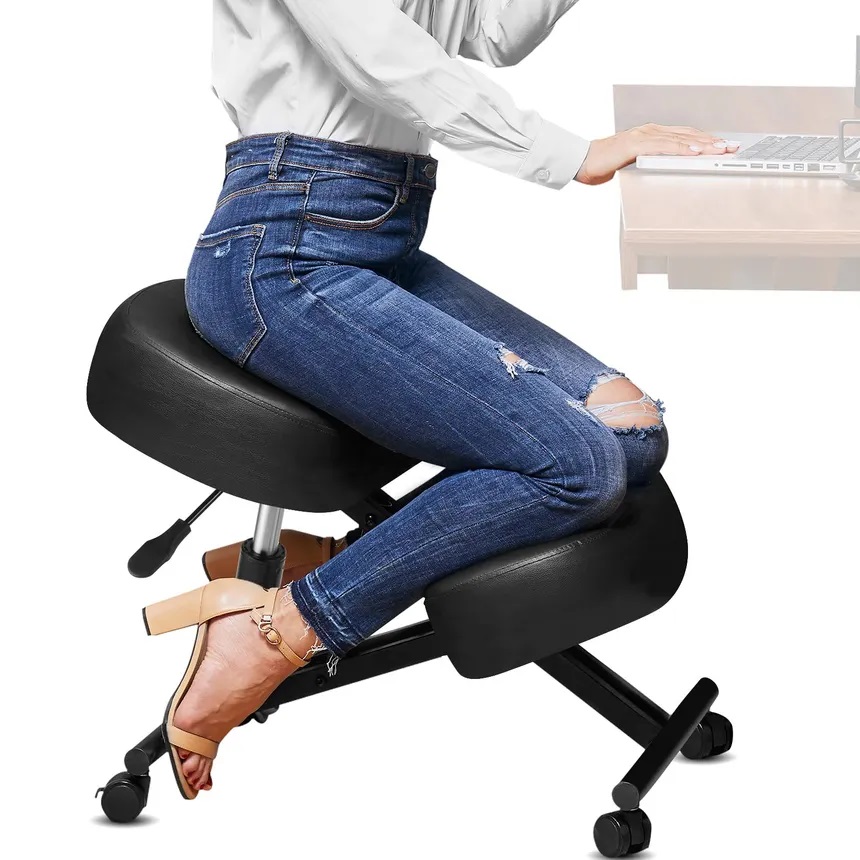The typical workday for office professionals involves long hours sitting at a desk, which often leads to physical discomfort and mental fatigue. As health and wellness trends continue to reshape workplace norms, the ergonomic kneeling desk chair has gained significant attention for its promise to support better posture and boost overall performance. But how exactly does changing your seat improve how well you work?
It’s easy to underestimate the impact that your chair has on your energy levels, attention span, and creativity. Most people associate productivity with time management and focus tools, but physical posture plays a hidden, yet powerful, role. When your body feels supported and your spine is in alignment, your brain can function more clearly. An ergonomic kneeling chair is designed specifically to keep you upright, balanced, and physically engaged while you work. This chair does more than just hold your body; it trains it.
The Mind-Body Connection Behind Better Work Performance
There’s no denying it how your body feels affects how your brain functions. When you’re slouched, compressed, or dealing with back pain, it becomes harder to focus. Your body uses more energy trying to stay comfortable, leaving less mental power for the task at hand. That’s where an ergonomic kneeling chair steps in; it encourages you to sit with a neutral spine, which keeps your lungs open, your circulation strong, and your core muscles slightly activated throughout the day.
This simple adjustment has a profound psychological effect. Workers often report feeling more focused, more present, and less mentally drained after switching to a kneeling chair. It becomes easier to stay engaged in your work, tackle big tasks, and avoid the mid-afternoon crash that standard chairs tend to trigger.
Many wellness-focused workers are also pairing these ergonomic solutions with smart technology. Tools like smartwatch women’s devices have become popular companions to the ergonomic kneeling desk chair. These watches remind users to move, stand up, breathe deeply, and track vital signs. Combined with better posture, these habits lead to more conscious and productive work habits.
Rethinking Workplace Comfort for Peak Efficiency
We’ve grown up thinking that comfort means softness, plush cushions, reclined seats, and minimal effort. But when it comes to work efficiency, too much comfort can backfire. Standard office chairs may seem cozy, but they encourage a passive, often slouched position that gradually fatigues both the body and the mind.
The ergonomic kneeling chair flips that narrative. By slightly tilting the pelvis forward and resting your shins on knee pads, the chair promotes active sitting. This doesn’t mean it’s tiring—it simply requires mild muscle engagement, especially in your back and core. Your body stays alert, and so does your mind. This form of active sitting leads to sustained energy, fewer distractions, and a surprising boost in motivation.
When you remove the aches, stiffness, and sluggishness that come from a bad chair, you create space for productivity to thrive naturally.
Enhancing Focus Through Physical Alignment
Focus isn’t just a mental state; it’s a full-body experience. Think about the last time you tried to concentrate while feeling physical discomfort. That tightness in your shoulders, the dull ache in your lower back, or the tingling in your legs pulls your attention away from your work.
Sitting in an ergonomic kneeling chair reduces or eliminates many of those physical distractions. With your body in a balanced position, your brain has more bandwidth to devote to creative thinking, strategic planning, or analytical problem-solving. The energy once wasted on fidgeting and readjusting is now redirected toward productivity.
Research also suggests that upright posture can improve mental resilience. People in confident, open postures tend to handle stress better, make decisions more efficiently, and communicate more assertively. All of these benefits feed directly into better performance at work.
Boosting Energy and Preventing the 3 PM Slump
One of the biggest productivity killers is the midday crash when your body begins to feel heavy, your eyelids droop, and your motivation fades. While this dip can be influenced by meals or lack of movement, posture is a major contributor. Traditional chairs encourage a reclined, low-energy posture, making it easier for your body to sink into fatigue.
An ergonomic kneeling chair combats that slump by keeping your spine in a vertical alignment. This helps maintain optimal oxygen flow and blood circulation. With better breathing and more energy reaching your brain, you’re less likely to feel drowsy. Instead, you stay sharp, alert, and ready to handle the second half of your workday.
Users often compare the energy boost from a kneeling chair to that of light exercise—it’s subtle but powerful. You’re not burning calories at a treadmill pace, but you are actively engaging muscles that stimulate the nervous system and keep your body “switched on.”
Supporting Long-Term Postural Health for Consistent Output
Sitting in the wrong position for years takes its toll. Chronic back pain, poor circulation, carpal tunnel syndrome—these issues don’t just affect your body; they impact your ability to produce high-quality work. Workers who are in pain or discomfort take more sick days, are less likely to take on extra tasks, and experience burnout faster.
The ergonomic kneeling chair isn’t just about feeling good today; it’s about protecting your health in the long run. By encouraging proper alignment, it helps build better sitting habits that continue to benefit you even when you’re not working. Over time, your posture improves, your muscle memory strengthens, and your core becomes more stable.
This creates a powerful upward cycle: better posture leads to better health, which leads to better performance, which reinforces the habit of sitting properly. You’re not just working more efficiently—you’re building a healthier you in the process.
The Psychology of Workspace Design
Your environment has a huge influence on your mindset. When your workspace is intentionally designed for comfort, flow, and well-being, your brain responds with a clearer, calmer, and more motivated state.
Adding an ergonomic kneeling chair to your setup is a bold visual cue—it signals to your brain (and others) that this is a space dedicated to conscious work. It breaks the norm of slouched, disengaged office culture and introduces a more empowered, intentional energy. You begin to associate your desk not just with tasks, but with health and progress.
Combining that with smart tools like habit-tracking apps, vision boards, or smartwatch women’s reminders creates a multi-layered productivity environment. You’re not relying on discipline alone; you’re shaping a system that supports you.
The Learning Curve: What to Expect When You Switch
Transitioning to an ergonomic kneeling chair is a bit like starting a new workout. It might feel unfamiliar at first. Some users report mild soreness in their back or thighs during the first few days. This is normal, your posture muscles are waking up and adapting.
To ease into it, experts recommend alternating between your kneeling chair and a traditional chair for the first week or two. As your body builds strength and awareness, you’ll naturally start to prefer the kneeling chair for longer periods. It’s not about forcing a change—it’s about giving your body time to evolve.
With patience and consistency, most users find that sitting on the kneeling chair becomes second nature, and they’re often surprised by how quickly it improves their work performance.
How Employers and Workspaces Are Responding
Forward-thinking companies are beginning to recognize the value of ergonomics not just as a perk, but as a strategic productivity tool. Providing ergonomic kneeling chairs in offices, co-working spaces, or remote work stipends reflects a deeper understanding of what employees need to thrive.
Happy, healthy workers produce better results. They make fewer errors, communicate more clearly, and show higher levels of engagement. That’s why some of the world’s most innovative companies are redesigning office spaces with wellness in mind—and kneeling chairs are playing a growing role in that shift.
These companies also find that offering ergonomic options helps with retention and recruiting. It’s a sign that the business values long-term health, not just short-term output.
Blending Ergonomics with Tech for Optimal Productivity
In the age of hybrid work, many professionals are using wearables, apps, and AI tools to stay organized and accountable. Integrating a physical upgrade like an ergonomic kneeling chair into that tech ecosystem creates a powerful combination.
Imagine a workflow where your smartwatch women model gently reminds you to stand every hour, stretch your spine, and take deep breaths. Meanwhile, your kneeling chair supports your posture and keeps your energy flowing. Together, they create a seamless feedback loop—your body and mind stay aligned, and your work benefits.
This is the future of productivity: a holistic approach that sees your tools, your chair, and your behavior as part of one intelligent system.
Final Thoughts
So, how does sitting on an ergonomic kneeling chair affect productivity? The answer is it changes everything. It transforms your posture, elevates your focus, prevents fatigue, and contributes to long-term health benefits that ripple through every area of your work life. While it might seem like a small shift, switching to a kneeling chair can have enormous impacts on how you think, feel, and perform. It’s not just about sitting differently—it’s about working smarter, more sustainably, and more consciously.








